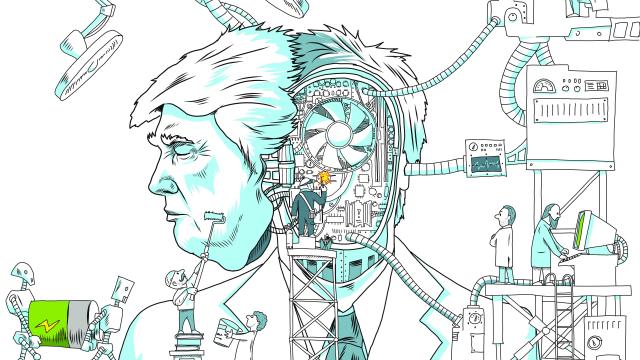With the proliferation of generative AI, we’ve come to the point where technology has helped compound the sense of distrust in both media and politics that exploded during the four-year presidency of Donald Trump. Nobody is immune to deepfake suspicion, not even Trump himself.
On Thursday, former Fox News commentator and prominent Trump supporter John Solomon and co-host Amanda Head touted an “exclusive interview” with the former president on the right-wing Real America’s Voice network. The dialogue was conducted on the phone, and for 17 minutes the apparent Trump waxed on and on about his usual grievances against Democrats and his indictments for trying to overturn the 2020 election.
Users viewing the content on the right-wing media site Rumble were quick to point out various irregularities with Trump’s speech. In a clip of the interview posted to the Real America’s Voice Twitter account, this supposed Trump spoke at a higher pitch than usual. There were other audio hiccups where the former president seemed to cut out or warble when speaking words like “Ukraine.” Some prominent members of conservative politics, such as communications director for the right-wing PAC Never Back Down Matt Wolking, wrote: “It does not sound like Donald Trump.”
The Daily Beast picked up on the audio irregularities and commenter conspiracies in a story published Friday. Solomon claimed to The Daily Beast that it was a real, flesh-and-blood Trump on the other end of the line. The far-right pundit said he set up the interview with Trump’s staff, and that they called in at a pre-arranged number.
The Daily Beast itself got caught up in the hall of mirrors surrounding Trump’s nasally and awkward audio. The outlet first claimed it spoke to Robert Sigg, the owner of Performance One Media, the parent company of Real America’s Voice. Sigg supposedly said that Trump sounded like “ChatGOP” and the network is launching an internal investigation. But later, the Beast updated the story saying a reporter had texted a number that had once belonged to Sigg according to public records, and the network has subsequently contacted the publication to inform them they were never communicating with the real Sigg.
In an email statement to Gizmodo, an RAV spokesperson said that the real Trump had been interviewed on the Network. The conservative media network further said that the quotes by Sigg published by The Daily Beast were “scurrilous lies in a fake quote that The Daily Beast never received from our network” adding that The Daily Beast may have been “‘punked’ into believing they had a qualified quote from us.”
Gizmodo reached out to the Trump campaign for comment, but we did not immediately hear back. Trump, for his part, reposted a clip from the interview on his own Truth Social account—indicating that either the clip is real or Trump is enjoying the warping of reality.
It seems the fakes are out and in force. Since 2016, Donald Trump’s whole strategy has been to convince his followers, and the public at large, that you shouldn’t trust the powers that be, whether that’s the media or the government itself. Now that suspicion and distrust has turned on conservative media and Trump himself. There’s reason to believe Trump would use a fake version of himself in an interview. The Trump campaign has used deepfakes in the past, having created a fake Twitter Space that included a fake Hitler, Satan, and Elon Musk to mock political opponent Ron DeSantis. DeSantis’ campaign has also used AI to blast his main competition for the GOP presidential ticket.
Such a long interview would be hard to pull off with most user-end AI voice synthesizers. A person behind a computer would have to use a text-to-speech program for 17 full minutes, all the while answering questions with minimal lag time. There are programs like Voicemod to modify users’ speech in real-time, but on the whole, they’re not nearly as capable as current AI models like ElevenLabs which can clone voices and then spit out realistic-sounding language from text.
Internet prankster Prank Stallone has humiliated far-right figures such as Alex Jones by using a text-to-voice AI model to spoof Tucker Carlson. A similar prank was pulled against Jordan Peterson using a voice to sound like fellow conservative figurehead Ben Shapiro. However, audio clips of the conversations were much more staggered and choppier than Trump’s 17-minute screed, and they lasted just a few minutes before being cut off.
Trump could have just had a cold, or it could have been an AI-synthesized voice. But it may not matter. For the former President, the idea that no one should believe anything they see or hear could be the ultimate realisation of a years-long project. And while it seems unlikely that Trump has an intern doing AI-juiced interviews in his place, he might want to consider it. A robot Trump could be a handy tool to have on the campaign trail while he takes on the enormous task of fending off four indictments.
